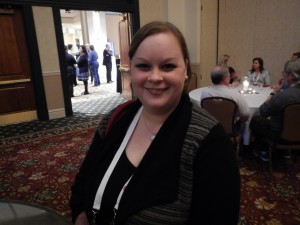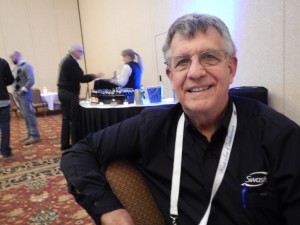Review: Midwest Wine & Beer Conference
Despite the difficult weather, hundreds of winemakers, craft brewers and vendors turned out for the Midwest Grape & Wine + Craft Brew Conference in St. Charles, Missouri, February 4-7. The event was the first time organizers, Vineyard & Winery Management, Inc., had brought the wine and craft beer industries together. At the Tour de Brew, a Wednesday evening beer tasting event, Midwest Wine Press spoke with winemakers and vendors and found that the conference’s goal of fostering a Midwest beverage culture including wine, beer and cider was going down well. Vineyard & Winery Management’s CEO, Robert Merletti, believes these beverages have a lot in common including the types of customers, who are seeking something other than the same old Chardonnay.
Ron Dotson, winemaker for Summerside Winery and Meadery in Vinita, Oklahoma sees lots of synergy between beer making and winemaking. ‘I’m actually a beer drinker not a wine drinker, but I make wine,” he said. ‘As a matter of fact we tried at one time to make a beer at the winery. It was called Braggart, which they thought was a mead, but it was actually an ale and we didn’t have a license to make it because it’s considered a beer!” Dotson said his winery is considering making beer again, this time deliberately and with all the correct licenses!
Summerside’s five acres of vines includes three acres of Norton and two acres of Vignoles. However, their best-selling wine – and the one Dotson is most proud of – is a blackberry fruit wine that won a gold medal at last year’s Watonga Cheese festival’s wine competition. At the St Charles conference, Dotson particularly liked a session that taught him about a new additive that can fix the tartrates without having to cold stabilize the wine.
Cory Bomgaars, Vice-President of Winery Operations at Les Bourgeois Vineyards believes the synergy between beverage makers goes further: ‘I don’t really think that the craft distiller is that far from the craft winery or the craft brewer.” Les Bourgeois leases space at their winery to Broadway Brewery and is also involved in a distillery project.
‘I like the idea of having three different companies of whatever weird renegade alcohol producers that are hanging out and collaborating and trying to make the best regional products we can,” Bomgaars said.
Bomgaars was looking forward to a conference session on cold stabilization using mannoproteins. So far, he’d especially enjoyed a talk by Stone Hill Winery’s Sean Turnbull about dealing with herbaceousness and acid additions.
He also reported progress on an important issue that was the subject of a panel discussion at the conference: getting Midwest wines onto the wine lists of more restaurants. On a visit with his distributor to restaurants in Jefferson City, Columbia and Lake of the Ozarks, 11 out of 12 restaurants agreed to place at least one Les Bourgeois wine. Bomgaars said this wouldn’t have happened five years ago. ‘There’s a mindset change about regional wine going on, which is the first step we need to overcome,” he said.
See related story: Regional Wine Taster Publishes “Wine Lists of Shame: KC Restaurants that Serve No Local Wine”
Kerri Ernst, manager for St. Louis Wine & Beermaking, sells wine and beer making equipment, predominantly to the home wine or beer maker. Since her company opened for business five years ago, Ernst said she’s starting to see a lot more home winemakers experiment with making beer and visa-versa. She said it makes sense because they both require similar equipment. ‘Take carboys for example, it’s a versatile five or six gallon container. Your fermenting buckets, hydrometers, thermometers, and a lot of the little stuff is the same for making beer and wine at home.”
Glenn Caster, sales engineer for ARS/Swash Sanitizing Equipment, based in California, sells equipment to both the wine and beer industries. ‘What is interesting is the vendor base – with the exception of the grapes and the hops – there’s a tremendous crossover,” he said. ‘Our prime product is steam,” said Caster. ‘We have portable steam electric steam generators, that are pretty much green because there are no chemicals.” He explained that steam is the most effective way to deliver heat which denatures the sort of bacteria that hang around bottling lines, barrels, tanks, floors, walls and — his favorite – floor drains.
‘If you keep everything clean enough the wine makes itself, we’ve just got to stay out of the way,” said Caster, who is also a partner in Highlands Napa Valley Wines. ARS also sells humidification systems that can help improve winemaking, for example, by slowing evaporation rates and so reducing the need to top up barrels that loose wine to evaporation.
Based on what he’s observing in the Californian wine industry, Caster – like Bomgaars – suggests further synergies between different beverage industries are coming soon to the Midwest: ‘a lot of the [Californian] wineries are buying stills now.”






